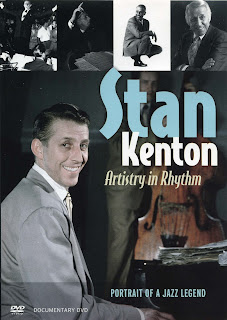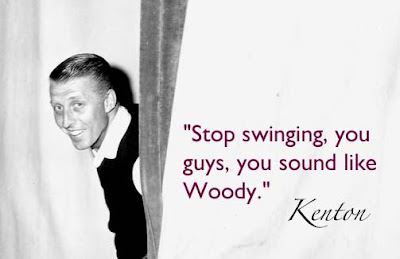Back in 1948, when I was 17 and only recently bitten by the jazz bug, all necessities of life were pushed aside and what little money I had went into the purchase of another record. My chance meeting with jazz, via radio, had sparked a preoccupation that totally warped my priorities. When my art school held classes at the Copenhagen zoo, found myself looking at hippos and Peruvian mountain goats, but drawing clarinetists and cornets. I was reminded of my impractical obsession each time I saw my mother darning my socks, of which I had four. It would, as she often reminded me, have been prudent to purchase a new pair, but there was that tempting, slightly worn Okeh Hot Five at Concerno, begging to be given a good home.
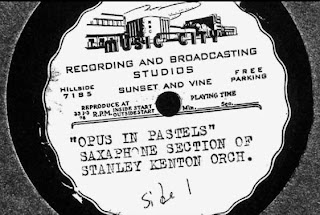 |
| Private test recordings were sent out as feelers. |
Concerno was a small used records shop in the center of Copenhagen, a place with bulging bins of abundant sounds. It did a thriving business in those years when new releases and pressing material were scarce. Record companies concocted all sorts of mixtures to stretch the shellac base, some even experimented with lamination, embedding a cardboard layer that a heavy needle soon found its way to. When I bought my first records, one had to hand in an old 78rpm disc when buying a new one, a system that stunted the growth of one's collection and gave one an added incentive to buy used records. Dan Morgenstern, who heads The Institute of Jazz Studies at Rutgers, can identify with that, for he himself was flipping through the bins at Concerno just a few years earlier.
Even with trade-in discs in hand, it was very difficult to find anything new in Copenhagen in the early post-war years, but there was Malmø, a small Swedish city across the water, and almost out of sight. Sweden had been neutral during WWII, so its stores offered all kids of goodies to anyone who had its currency or U.S. dollars, neither of which were readily available to Danes. I, however, also had an Icelandic passport, which was regarded as "foreign" and thus opened a door to currency exchange. There was no yellow brick road to Malmø, so I hopped a ferry whenever I could scrape up the money, which wasn't very often. The mission was to buy such things as real coffee, tea, chocolate, and nylon stockings for my family and jazz records for myself, but all these things soon became available in Denmark.
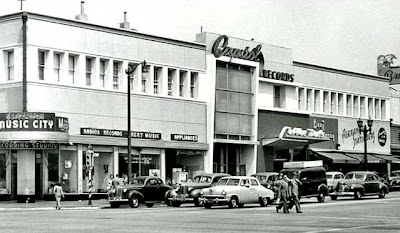 |
Before there was a Capitol Tower at Hollywood and Vine, there was this unimposing building. |
Capitol recordings had yet to reach us in Denmark, so I specifically asked the Swedish store clerk to show me its offerings. That's how I came across Nellie Lutcher, whom I couldn't get enough of, and how I discovered Kenton's brass orgies. The sheer volume overwhelmed me and I was intrigued by the dissonance. Then, too, there was that Capitol Records sound, almost cavernous, but never overly so, and unlike any audio I had heard before. The music was already energetic, but Capitol's engineers somehow seemed to give it extra life. Of course, much of it was simply reverb, which was a new thing that eventually would be used excessively by many labels, but on those Capitols it seemed just right. Not an exaggerated echo where notes disappeared into nooks and crannies, but just enough of a boost to enrich the sound of the music. I bought the well-named
Artistry Jumps—which then was two or three years old, but none the worse for it—and I became totally hooked. To me, Kenton's music sounded every bit as exciting as Jelly Roll's Red Hot Peppers or Bix and Tram, or Louis at his hottest—it was all jazz, and the fact that there were so many diverse approaches to it only made it more intriguing. We did not have Leonard Feather around to do his "hot versus cool" or "cats versus chicks" polarization-for-profit number. The European ear was open to all of it.
Just three minutes short of two hours in length, the film contains much of the music that attracted me to the band. The aforementioned Capitol sound that contributed to that attraction is not in evidence, because the music is mostly taken from film and television footage. It runs in the back and foregrounds throughout the documentary and weaves seamlessly in and out of the narrative. You will not hear complete, uninterrupted performances, but neither will you miss them, because producer/director Graham Carter keeps the information flowing. The basic running commentary is by Ken Poston, a historian from the Los Angeles Jazz Institute whose authoritative account of Kenton's career is helped along by the on-camera comments and recollections of a number of Kenton alumni, including Bill Holman, Jack Costanzo, Eddie Bert, an club owner Howard Rumsey, who played bass with Kenton in the early days. Veteran San Francisco jazz critic/disc jockey/producer Herb Wong also shares his recollections.
 |
| Kenton's rapturing reeds. |
It was written for him by Pete Rugolo, at Kenton's request, but Costanzo admits here for the first time that he was never happy with
Bongo Riff. It made him a star, he admits, but this new Afro Cuban Kenton sound was missing a key ingredient. "It was Latin music played by an American band," he says, adding that the chart severely restricted his creativity. Kenton would later send composer/arranger Johnny Richards to New York with instructions to hang out with the Latin players and find that missing key. Richards did as told and the result was "Cuban Fire," an enormously successful six-part suite released in 1956. Richards was also responsible for the highly successful
West Side Story album, and for Kenton's not so warmly received flirt with Richard Wagner. The latter release does not get a mention in the film.
Before he shifted the instrumentation to heavy brass (ten trumpets and ten trombones), Kenton's emphasis favored saxophones and the charts were... well, less progressive. In fact, an included snippet of
Reed Rapture brings to mind Raymond Scott, who often teetered on the edge of corn. from a time when sound tracks were of a lower fi. It is not easy to imagine Kenton's music played successfully by a band other than his own, which is probably why he was adamantly against so-called "ghost" bands.
 |
Kenton was upset with the trade press categorizing Bob Graettinger's tightly scored "City of Glass" as jazz. |
While the residue of a post-war "trad" fad could still be felt a decade after the war's end, Bunk eventually gave way to Monk and Bebop became something young Danes slipped onto their turntable, even as they continued dancing to the roots of jazz. Some Danes fanatically embraced this "progressive jazz", as Kenton dubbed it, but there were those who were left cold by it—they found the well disciplined brass to be too prescribed. It lacked "swing," they said, it was all precision and no soul, an evaluation many of Wynton Marsalis' detractors have since echoed. Stan Kenton took such criticism in stride and made a joke of it.
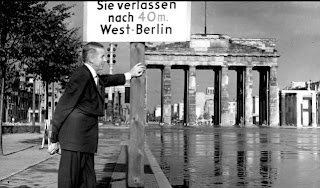 |
| Kenton in Berlin. |
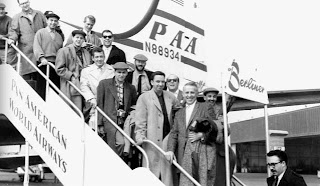 |
| Arriving in Berlin. It was Kenton's first visit. |
Getting back to Graham Carter's documentary, the music itself is almost secondary, which is as it should be, because this is a film about a man's pursuit of a dream, his stumbles, his triumphs, his personality, his constant efforts to reinvent himself. The film's "chapters" cover the many Kenton "eras", his founding of a record company, which he hoped could compete with Capitol, his short-lived but ultra ambitious Los Angeles Neophonic Orchestra, and other phases, each of which reflected the bandleader's quest for acceptance by a public whose taste was ever tenuous. While the music is there from start to finish, the recordings deserve to be heard uninterrupted and as issued. Kenton's discography is sizable and of, uneven merit, but there is plenty of the good stuff available in a variety of digital formats. The significance of this film, its real value, lies in what it tells us about Stan the man, himself, and some of that may surprise you.
 |
| Kenton poses with some of his clinic's students. Recognize anyone? |
Stan Kenton's most enduring legacy may well be in the field of jazz education. He not only built a succession of orchestras, he also thought it important to lay the foundation for future bands, ones that he himself might never hear, and to develop an audience for all that. That's why he founded the Stan Kenton Music Clinics, which numbered over 100 by the mid-Seventies . Young people were not always interested in his recordings, but they loved to hear the music played live, and it inspired many to follow that route. Kids who attended Kenton's clinics include Keith Jarrett, Gary Burton, Dave Sanborn, Randy Brecker, and Pat Metheny. A roll call that is almost as impressive as his list of alumni, the stars of which are too many to rattle off here—suffice it to mention that Lee Konitz, Shorty Rogers, Shelly Manne, Zoot Sims, Gerry Mulligan, Art Pepper, and Laurindo Almeida are among them. Vocalists? Well, there was Anita O'Day, followed by June Christy, who recommended Chris Connor.
The film also gives deserved space to Pete Rugolo, who—as Kenton acknowledged—was to Kenton what Billy Strayhorn was to Duke Ellington: a very talented alter-ego. I don't think any significant arranger was left out, but I wonder why there was not even a mention of Eddie Safranski, whose prominent bass fueled my imagination when I first heard
Artistry Jumps, or why saxophonist Vido Musso is all but fluffed over. His association with Kenton dated back to the 1930s, and his rich tenor sound seemed to defy the well organized background. Musso, an Italian, gave Kenton at least one big hit,
Come Back to Sorrento. But now I am nitpicking.
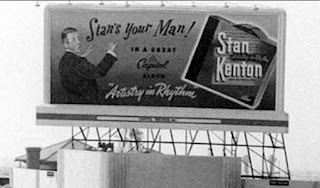 |
| A Los Angeles billboard. |
Kenton had several wives, two of whom appear in this film's closing segment, a sad account of the energetic, charismatic bandleader's last months, when a fall brought on a brain aneurysm that made him unable to recognize his most intimate associates and even his own music. Stan Kenton died in 1979, at the age of 67.
Kenton has been accused of racial discrimination, but unfairly so, I believe. Yes, the band was decidedly white, with a few late exceptions, but Kenton himself acknowledges in the film his early admiration for Louis Armstrong, Earl Hines and Benny Carter. Do we accuse Duke Ellington or Basie of discriminating against whites? Of course not.
Having but touched the surface as far as the merits of this DVD release are concerned, I recommend that you check it out.
See what you can find in Malmø?
Photos are stills from the film—they can be enlarged with a click.. 






